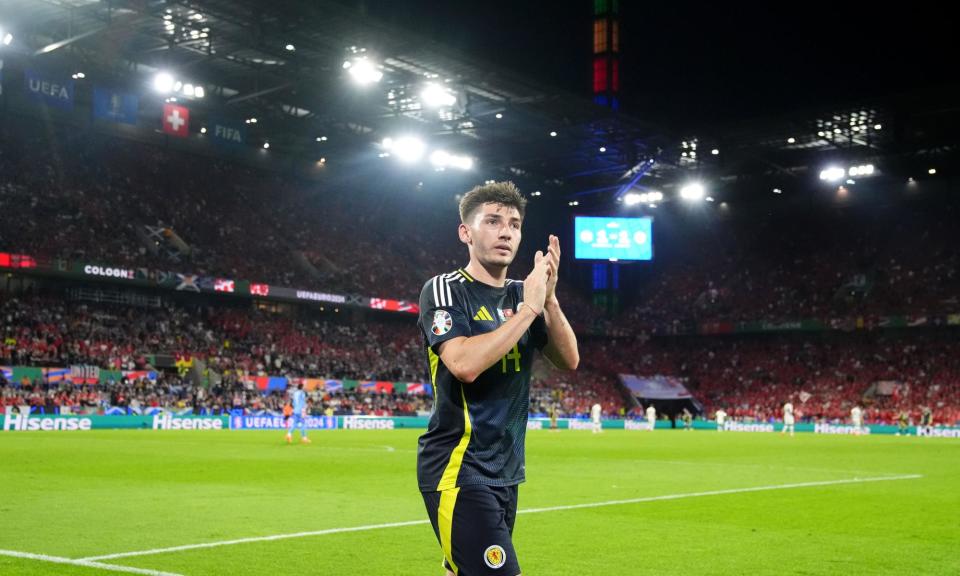Scotland learn to use Billy Gilmour’s talents and reap the rewards

Early on at the Cologne Stadium, on a night when Scotland carried out a kind of mini‑exorcism, packing away the horrors of Munich via a 1-1 draw with Switzerland, it seemed as though Steve Clarke’s team had a basic textural problem.
Billy Gilmour is their best passer, the setter of the midfield patterns. At the same time Gilmour wants to play football in a way that, frankly, doesn’t suit the players at the back, who looked at times bullied and harried by their own midfield playmaker, more concerned by being asked to pass the ball than they were by having to mark the Swiss attack.
When Gilmour had the ball there were slick, short passes, an attempt to build a sequence. Then suddenly someone else had it and it was all knee-pumping runs, helium balloon touches, possession as a kind of trauma, something to be shifted like a ticking package.
The fit looked wrong, the recipe doomed. With Gilmour spraying the ball around Scotland seemed to be trying to make a truffle risotto with a Pot Noodle, a can of Tennent’s and half a pound of cheddar. You might actually get the best results in the end just chugging it all down with a fork as God intended.
Then an interesting thing happened. The ballad of Billy Gilmour came in three phases. Early awkwardness. The low point, pegged out around Switzerland’s wonderful goal. And finally the peak Gilmour phase midway through the second half, as Gilmour and John McGinn grew into the game, began to affect the way teammates moved around them, Gilmour’s passing growing more direct, more vertical, more aggressive.
This was real progress. Scotland needed something from this game, if not a win, or even a draw, then at least to turn up and play and feel good about it. They got a point. They also found a way to play. Beat Hungary now and a team that looked dead on the table should even make the last 16.
Cologne had been a lovely soft summery place at kick-off. The stadium is a wonderful thing, a vast leafy open weathered complex, with a meadow out in front and a 1930s colonnade hiding its square metal outline. It feels very Echt German football, a vinyl gatefold album of a stadium.
In the opening exchanges the noise clattered around this massive vibrating box in unceasing waves. Scotland won an early corner on the left and it was like being battered in the side of the head.
At which point phase one of the ballad of Billy occurred. Gilmour is a lovely mover, relaxed in every touch. Early on he was taking the ball and signalling the next pass with his hand, although it was also clear the next player didn’t always seem ready to take it.
The Swiss goal came via this route. It was an equaliser at that stage. It was an astonishing point‑and‑shout moment from Xherdan Shaqiri. It was also made by Anthony Ralston’s poor pass across his own area. He was given the ball by Gilmour in a tight space where he just didn’t want it, and flapped it back into the space where he imagined Grant Hanley to be standing.
Unfortunately the most skilful, power-packed, impishly creative presence on the pitch just happened to be skirting into that empty green space. Shaqiri saw it all at once, ran the maths, pounded the turf a little harder, reading the strides, then took the ball first time with his left foot, lifting it with startling dip and swerve in a hard arc straight into the top corner.
Shaqiri went for a knee slide, stuck in the ground, ended in a kind of bear-cub roll. He has been many things, the Magic Dwarf, the Red Cube, Switzerland’s premier celebrity in his pomp. He still looks in great shape. His calves still appear to have calves of their own. This is a seriously talented footballer.
Phase two of Gilmour’s night was the struggle. Scotland played 25 long passes out of defence in the first half. They struggled to rest on the ball, to find any rhythm, any kind of pattern. The players never stopped running and harrying. Maybe sometimes it’s a good idea to stop running and harrying.
Related: Scotland keep knockout hopes alive after battling draw with Switzerland
But Scotland also scored a goal in this period, the first part of which was Shaqiri winning an improbable header on the edge of the Scotland box, hurling through the evening air like an action man with a jet pack. The ball dropped to Gilmour, who produced a wonderful quicksilver touch, reading the space ahead of him and releasing Andy Robertson.
From there it was just wonderful ball-carrying, Robertson taking the ball through just the right channel to retain Scotland’s overload. Callum McGregor cut the ball back to Scott McTominay whose shot struck the flailing knee of Fabian Schär and zinged into the top corner.
The roof air crackled, the blue-shirted section of the crowd seethed and tumbled. And after half-time came phase three. What happened was Scotland got better, found ways to pass and keep the ball, to pressurise the Swiss. They could have won this. Hanley hit the post. They also could have lost it. But the lesson seemed clear. Pick your best passer and play this way, no matter how hard the accommodation.

 Yahoo Sport
Yahoo Sport 






































